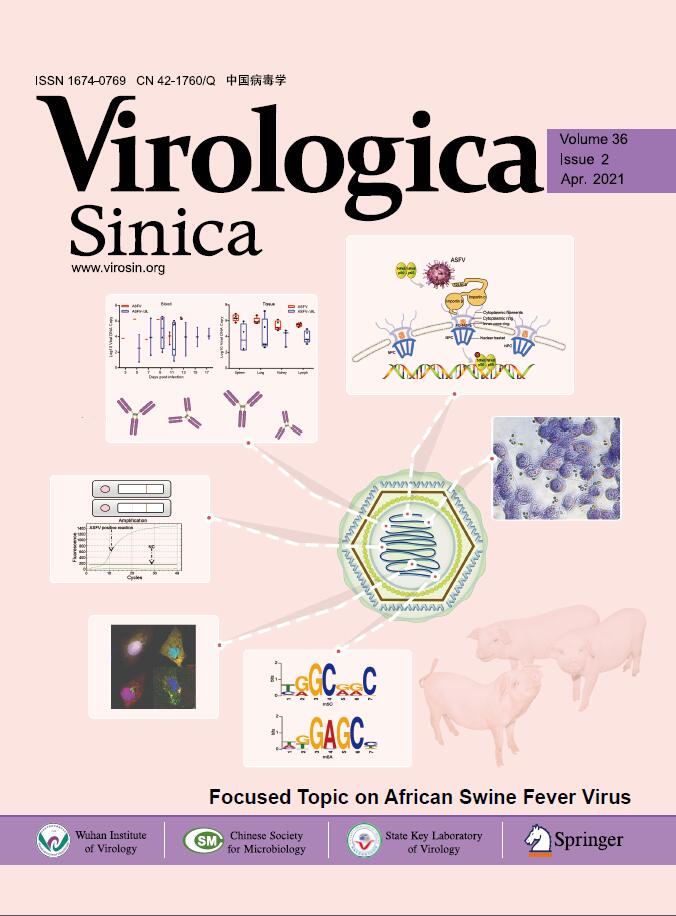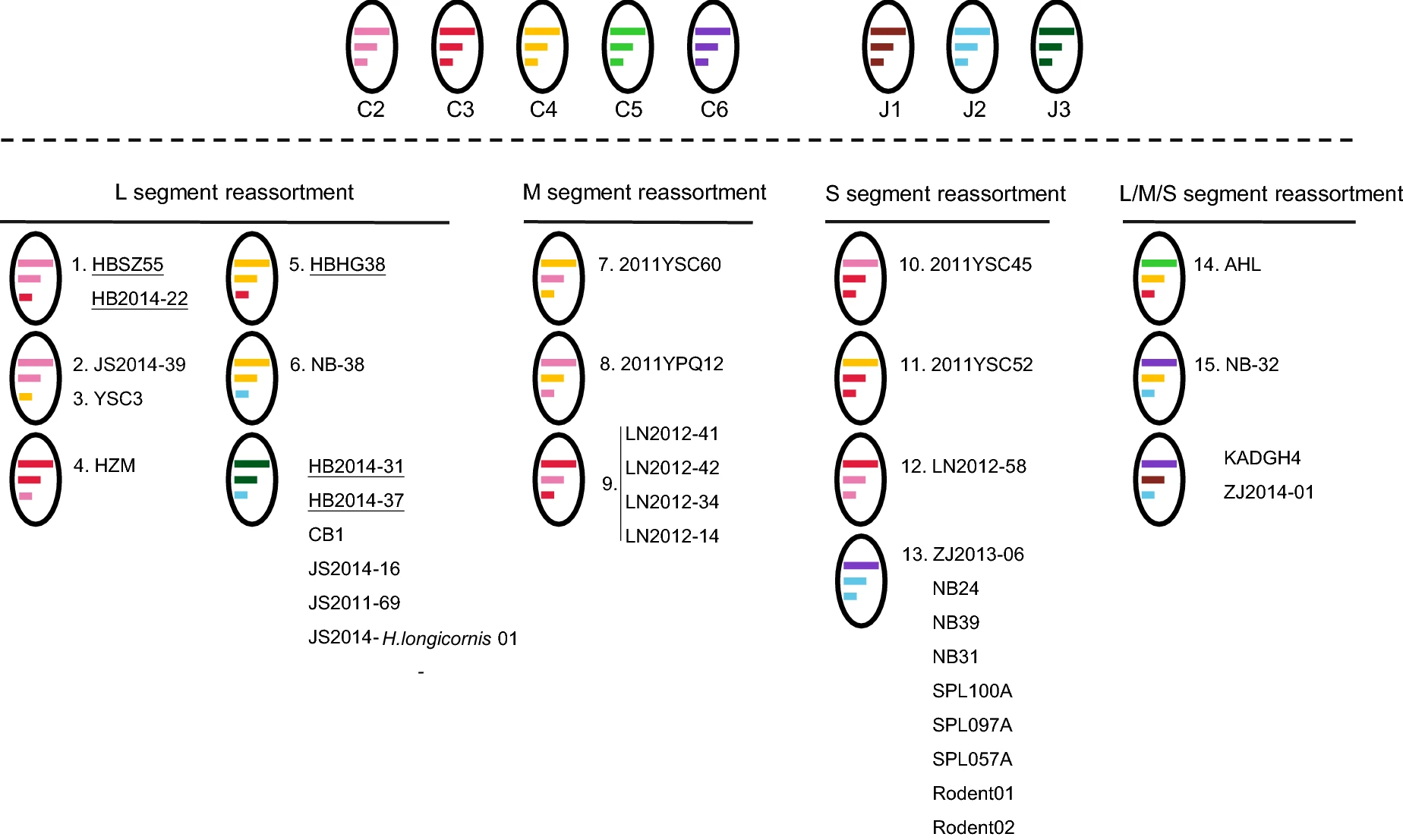-
Hu B, Cai K, Liu M, Li W, Xu J, Qiu F, Zhan J (2018) Laboratory detection and molecular phylogenetic analysis of severe fever with thrombocytopenia syndrome virus in Hubei Province, central China. Arch Virol 163:3243-3254
doi: 10.1007/s00705-018-3993-5
-
Kim K, Kim J, Ko M, Chun J, Kim H, Kim S, Min J, Park W, Oh M, Chung J (2019) An anti-Gn glycoprotein antibody from a convalescent patient potently inhibits the infection of severe fever with thrombocytopenia syndrome virus. PLoS Pathog 15:e1007375
doi: 10.1371/journal.ppat.1007375
-
Lee S, Cho Y, Jeong H, Kim W, Son K, Kim J, Oh S, Jheong W, Chaeb J (2019) Complete genome sequences of two severe fever with thrombocytopenia syndrome virus strains isolated from a human and a dog in the republic of Korea. Microbiol Resour Announc 8:e01695-18
-
Lv Q, Zhang H, Tian L, Zhang R, Zhang Z, Li J, Tong Y, Fan H, Carr M, Shi W (2017) Novel sub-lineages, recombinants and reassortants of severe fever with thrombocytopenia syndrome virus. Ticks Tick Borne Dis 8:385-390
doi: 10.1016/j.ttbdis.2016.12.015
-
Mahmood N, Khurram M, Khan M, Umar M, Jalil A, Sharif S (2019) Characteristics of probable severe fever with thrombocytopenia syndrome patients:a perspective study from Pakistan. Int J Med Devel Ctries 3:8
-
McMullan L, Folk S, Kelly A, MacNeil A, Goldsmith C, Metcalfe M, Batten B, Albariño C, Zaki S, Rollin P, Nicholson W, Nichol S (2012) A new phlebovirus associated with severe febrile illness in Missouri. N Engl J Med 367:834-841
doi: 10.1056/NEJMoa1203378
-
Park E, Shimojima M, Nagata N, Ami Y, Yoshikawa T, Iwata-Yoshikawa N, Fukushi S, Watanabe S, Kurosu T, Kataoka M, Okutani A, Kimura M, Imaoka K, Hanaki K, Suzuki T, Hasegawa H, Saijo M, Maeda K, Morikawa S (2019) Severe fever with thrombocytopenia syndrome phlebovirus causes lethal viral hemorrhagic fever in cats. Sci Rep 9:11990
doi: 10.1038/s41598-019-48317-8
-
Reece L, Beasley D, Milligan G, Sarathy V, Barrett A (2018) Current status of severe fever with thrombocytopenia syndrome vaccine development. Curr Opin Virol 29:72-78
doi: 10.1016/j.coviro.2018.03.005
-
Shi J, Hu S, Liu X, Yang J, Liu D, Wu L, Wang H, Hu Z, Deng F, Shen S (2017) Migration, recombination, and reassortment are involved in the evolution of severe fever with thrombocytopenia syndrome bunyavirus. Infect Genet Evol 47:109-117
doi: 10.1016/j.meegid.2016.11.015
-
Sun J, Lu L, Wu H, Yang J, Ren J, Liu Q (2017) The changing epidemiological characteristics of severe fever with thrombocytopenia syndrome in China, 2011-2016. Sci Rep 7:9236
doi: 10.1038/s41598-017-08042-6
-
Tani H, Kawachi K, Kimura M, Taniguchi S, Shimojima M, Fukushi S, Igarashi M, Morikawa S, Saijo M (2019) Identification of the amino acid residue important for fusion of severe fever with thrombocytopenia syndrome virus glycoprotein. Virology 535:102-110
doi: 10.1016/j.virol.2019.06.014
-
Tran X, Yun Y, Le Van An SHK, Kim S, Thao N, Man P, Yoo J, Heo S, Cho N, Lee K (2019) Endemic severe fever with thrombocytopenia syndrome, Vietnam. Emerg Infect Dis 25:1029-1031
doi: 10.3201/eid2505.181463
-
Wu Y, Zhu Y, Gao F, Jiao Y, Oladejo BO, Chai Y, Bi Y, Lu S, Dong M, Zhang C, Huang G, Wong G, Li N, Zhang Y, Li Y, Feng WH, Shi Y, Liang M, Zhang R, Qi J, Gao GF (2017) Structures of phlebovirus glycoprotein Gn and identification of a neutralizing antibody epitope. Proc Natl Acad Sci USA 114:E7564-E7573
doi: 10.1073/pnas.1705176114
-
Yang L, Zhao Z, Hou G, Zhang C, Liu J, Xu L, Li W, Tan Z, Tu C, He B (2019) Genomes and seroprevalence of severe fever with thrombocytopenia syndrome virus and Nairobi sheep disease virus in Haemaphysalis longicornis ticks and goats in Hubei, China. Virology 529:234-245
doi: 10.1016/j.virol.2019.01.026
-
Yoshikawa T, Shimojima M, Fukushi S, Tani H, Fukuma A, Taniguchi S, Singh H, Suda Y, Shirabe K, Toda S, Shimazu Y, Nomachi T, Gokuden M, Morimitsu T, Ando K, Yoshikawa A, Kan M, Uramoto M, Osako H, Kida K, Takimoto H, Kitamoto H, Terasoma F, Honda A, Maeda K, Takahashi T, Yamagishi T, Oishi K, Morikawa S, Saijo M (2015) Phylogenetic and geographic relationships of severe fever with thrombocytopenia syndrome virus in China, South Korea, and Japan. J Infect Dis 212:889-898
doi: 10.1093/infdis/jiv144
-
Yu X, Liang M, Zhang S, Liu Y, Li J, Sun Y, Zhang L, Zhang Q, Popov V, Li C, Qu J, Li Q, Zhang Y, Hai R, Wu W, Wang Q, Zhan F, Wang X, Kan B, Wang S, Wan K, Jing H, Lu J, Yin W, Zhou H, Guan X, Liu J, Bi Z, Liu G, Ren J, Wang H, Zhao Z, Song J, He J, Wan T, Zhang J, Fu X, Sun L, Dong X, Feng Z, Yang W, Hong T, Zhang Y, Walker D, Wang Y, Li DX (2011) Fever with thrombocytopenia associated with a novel bunyavirus in China. N Engl J Med 364:1523-1532
doi: 10.1056/NEJMoa1010095
-
Zhan J, Wang Q, Cheng J, Hu B, Li J, Zhan F, Song Y, Guo D (2017) Current status of severe fever with thrombocytopenia syndrome in China. Virol Sin 32:51-62
doi: 10.1007/s12250-016-3931-1
-
Zhang Y, Zhou D, Xiong Y, Chen X, He Y, Sun Q, Yu B, Li J, Dai Y, Tian J, Qin X, Jin D, Cui Z, Luo X, Li W, Lu S, Wang W, Peng J, Guo W, Li M, Li Z, Zhang S, Chen C, Wang Y, Xu J (2011) Hemorrhagic fever caused by a novel tick-borne Bunyavirus in Huaiyangshan, China. Chin J Epidemiol 32: 209-220 (in Chinese)
-
Zhang Y, Shen S, Shi J, Su Z, Li M, Zhang W, Li M, Hu Z, Peng C, Zheng X, Deng F (2017) Isolation, characterization, and phylogenic analysis of three new severe fever with thrombocytopenia syndrome bunyavirus strains derived from Hubei Province, China. Virol Sin 32:89-96
doi: 10.1007/s12250-017-3953-3















